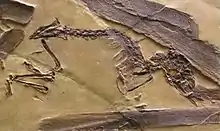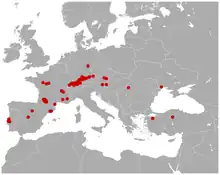Prolagus oeningensis
Prolagus oeningensis is an extinct lagomorph and the type species of its genus, Prolagus. It lived from 15.97 to 7.75 Ma, existing for about 8 million years.
| Prolagus oeningensis | |
|---|---|
 | |
| Scientific classification | |
| Domain: | Eukaryota |
| Kingdom: | Animalia |
| Phylum: | Chordata |
| Class: | Mammalia |
| Order: | Lagomorpha |
| Family: | Ochotonidae |
| Genus: | †Prolagus |
| Species: | †P. oeningensis |
| Binomial name | |
| †Prolagus oeningensis König, 1825 | |
 | |
| Synonyms | |
| |
Range
The species has been found in various locations in Europe and Asia. It was named after the town of Öhningen in Germany, its type locality in the Upper Freshwater Molasse.[4]
Diet
This species was possibly a herbivore like other living lagomorphs.
Notes
References
- Ge, Deyan; Wen, Zhixin; Xia, Lin; Zhang, Zhaoqun; Erbajeva, Margarita; Huang, Chengming; Yang, Qisen (April 3, 2013). "Evolutionary History of Lagomorphs in Response to Global Environmental Change". PLOS ONE. 8 (4:e59668): e59668. Bibcode:2013PLoSO...859668G. doi:10.1371/journal.pone.0059668. PMC 3616043. PMID 23573205.
Table_S1.xls
{{cite journal}}: External link in|quote= - "The Paleobiology Database. †Prolagus oeningensis König 1825 (pika)". Retrieved 2015-03-12.
- Wilson & Reeder's Mammal Species of the World. "Prolagus". Smithsonian National Museum of Natural History.
- Ellen Boon-Kristkoiz (2003). "Prolagus oeningensis (Lagomorpha, Mammalia) from the Middle Miocene of Mühlbach am Manhartsberg,Lower Austria" (PDF). Annalen des Naturhistorischen Museums Wien. 104 A: 293–296.
Additional references of the Paleobiology Database
- Antunes, M. T.; Mein, P. (1981). "Vertébrés du miocène moyen de amor (Leiria) - importance stratigraphique". Ciências da Terra. 6: 169–188.
Paleobiology Database: Amor, point 1 ("premiere gisement" of Zbyszewski)", Amor, points 2 to 5 (Miocene of Portugal) - Buffetaut, E.; Crouzel, F.; Juillard, F.; Stigliani, F. (1984). "Le crocodilien longirostre Gavialosuchus dans le Miocene moyen de Polastron (Gers, France)". Geobios. 17 (1): 113–117. Bibcode:1984Geobi..17..113B. doi:10.1016/s0016-6995(84)80009-1.
Paleobiology Database: Polastron (Miocene of France) - Heissig, K. (1989). "Neue Ergebnisse zur Stratigraphie der mittleren Serie der Oberen Süßwassermolasse Bayerns (New results on the stratigraphy of the middle series of upper Freshwater Molasse, Bavaria)". Geologica Bavarica. 94: 239–257.
Paleobiology Database: Ziemetshausen 1b, 1a (Miocene of Germany) - Ginsburg, L.; Bonneau, M. (1995). "La succession des faunes de mammiferes miocenes de Pontigne (Maine-et-Loire, France)". Bulletin du Muséum National d'Histoire Naturelle. 4 (2–4): 313–328.
Paleobiology Database: Pontigne 4 (marine) (Miocene of France) (les Buissoneaux) - Böttcher, R.; Heizmann, E. P. J.; Rasser, M. W; Ziegler, R. (2009). "Biostratigraphy and palaeoecology of a Middle Miocene (Karpathian, MN 5) fauna from the northern margin of the North Alpine Foreland Basin (Oggenhausen 2, SW' Germany)". Neues Jahrbuch für Geologie und Paläontologie, Abhandlungen. 254 (1/2): 237–260. doi:10.1127/0077-7749/2009/0011.
Paleobiology Database: Oggenhausen 2 (Miocene of Germany) - Additional contributors to utilized records of Paleobiology Database (authorizers supplying these records) include Johannes Mueller, Philip Mannion, John Alroy, Mark Uhen.
This article is issued from Wikipedia. The text is licensed under Creative Commons - Attribution - Sharealike. Additional terms may apply for the media files.